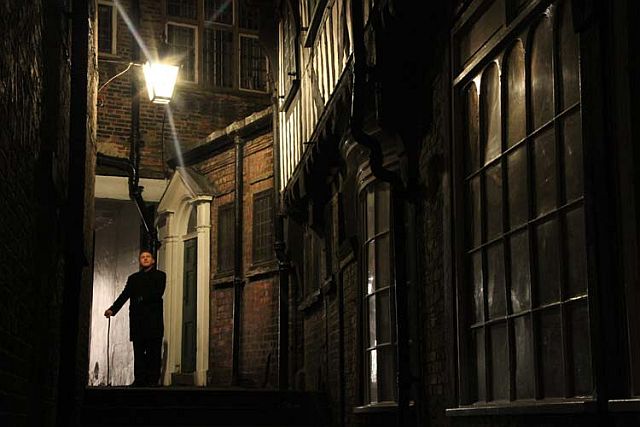 |
| Many cities in the United Kingdom have "Ghost Walks" but York, England is the perfect place for a scary stroll (wikipedia) |
A good way to get oriented is
to circumnavigate the perfectly preserved walls surrounding the city. From
there, walk into the heart of the village and immerse yourself in its ancient
streets.
Located at the confluence of
the Ouse and Foss Rivers, York has long been a crossroads as well as a backdrop
for major political events throughout its two thousand year history.
The city was founded in 71 AD
by the Romans and, at one time or another, during various campaigns, the
Emperors Hadrian, Septimius Severus and Constantius I all held court in York.
 |
| The Jorvik Viking Centre is filled with history (wikipedia) |
In 866, the region of Northumbria
was raided by the Vikings bringing York under their rule. It was during this
period that York became a major river port for Viking trade throughout northern
Europe. By 954, less than a century later, the last Jorvik (Viking) ruler, Eric
Bloodaxe, was driven from the city during King Eadred’s successful efforts to
unify England.
Over time, the word Jorkiv underwent numerous iterations
before if eventually became known as “York.”
In 1068, two years after the Battle of Hastings and the
Norman conquest of England ,
the citizens of York
Over the next thousand years, York
 |
| York's wall are completely intact which means you can orient yourself by walking the ancient walled path (wikipedia) |
Perhaps it is the surrounding walls that provide the
slightly claustrophobic sense of concentration that makes everything in York
 |
| York Minster is famous for its massive stained glass windows (wikipedia) |
Begin with the historic York Minster, the largest Gothic
cathedral in Northern Europe . Some of the
stained glass in the church dates to the 12th century with the Great
East Window, completed in 1408, still surviving as one of the largest examples
of medieval stained glass in the world. Though the minster dwarfs the sense of
proportion of the windows, many are larger than a full sized tennis court.
Next stroll to the ancient street known as the Shambles
with its timber-framed buildings. This was the meat market in the 14th
and 15th centuries where butchers displayed their wares. Though the
butcher shops no longer remain, they were active until as recently as 1872.
 |
| The Shambles are a popular site (wikipedia) |
As you amble through the Shambles, stop to visit No. 10,
which has become a shrine for the area. Today, the shop sells cufflinks rather
than meat.
Though not in the city center, the Jorvik Viking Centre
provides an excellent history of the influence of the Vikings on the region of Northumbria and their role in the history of the
United Kingdom
One museum that should not be missed however, is the National Railway Museum outside the city walls of York
 |
| The National Railway Museum is about transportation of all kinds including those famous double decked buses (wikipedia) |
Though the museum focuses upon the historic connections
of the British railway system, it is actually a museum of transportation that features
other modes of travel throughout the centuries.
 |
| If you miss Betty's Tea Rooms, your visit to York is not complete...Try the mint tea with scones and clotted cream (wikipedia) |
Just when the “thrill of victory” is ready to yield to
the “agony of the feet” head for Betty’s Tea Rooms to sample mint tea and
scones with clotted cream. Warning, Betty’s is a world famous institution so be
prepared to wait…it is well worth it.
And speaking of confectionery delights, thanks to York
 |
| Clifford's Tower was built in the 11th century by William the Conqueror (wikipedia) |
Finally, no country has more ghosts per capita than the United Kingdom and, arguably, no city has a
greater concentration of spooky stories than York England and Scotland
feature ghost walks, but none are better than the ones in York
 |
| Enter the medieval archways of York and indulge yourself in a world of history and nostalgic remnants of the past (wikipedia) |
With its narrow streets and medieval setting, York
For pure nostalgia and visiting England the way it “used to be” York



























